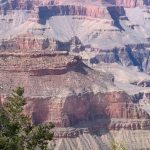EGYPT – 2023
Pat and I like to travel but we had been sidelined because of COVID-19. This was our first real trip since October 2019.
Our flight left on Sunday September 24th at 10 pm from Chicago O’Hare to Istanbul, Turkey, then on to Cairo, Egypt. We had arranged to arrive two days ahead of our tour so we could get used to the time-zone change (7 hours) and be reasonably rested.
Tuesday September 26, 2023
We were met at the airport by a representative of Alexander and Roberts (A&R) who helped us through customs and immigration. A waiting car took us to the Kempinski Hotel for check in. The hotel is in downtown Cairo, right on the Nile River.
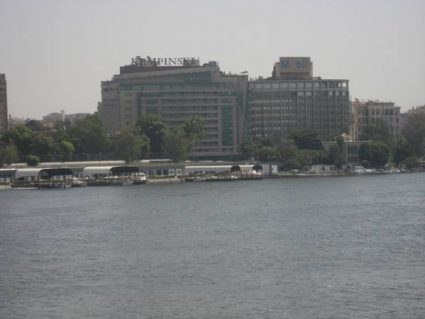
Our room was on the Nile River side of the hotel and we had great views.
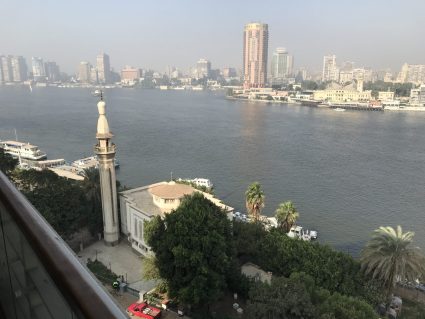
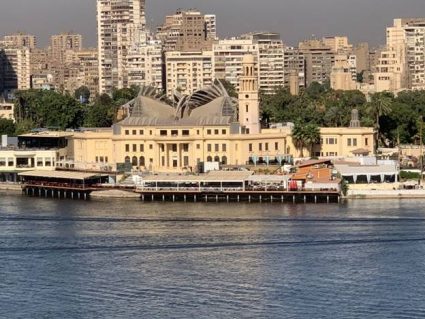
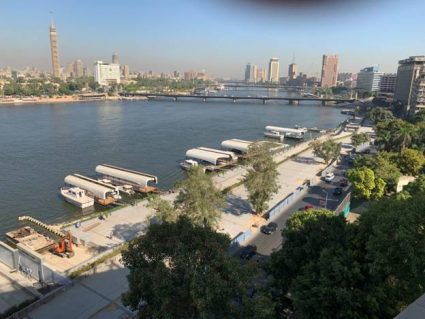
It was mid-day so we put on walking shoes and spent the afternoon strolling the neighborhood.
Back at the hotel, we spent the later part of the afternoon at the hotel pool on the roof.
Wednesday September 27, 2023
We had asked the A&R representative for some suggestions to visit in Cairo that weren’t included on the scheduled tour. He recommended the Citadel which was a short taxi ride from our hotel.
The Salah al-Din al-Ayyubi Citadel was built in 1176 AD and, for a period, became the seat of Egypt’s rule.
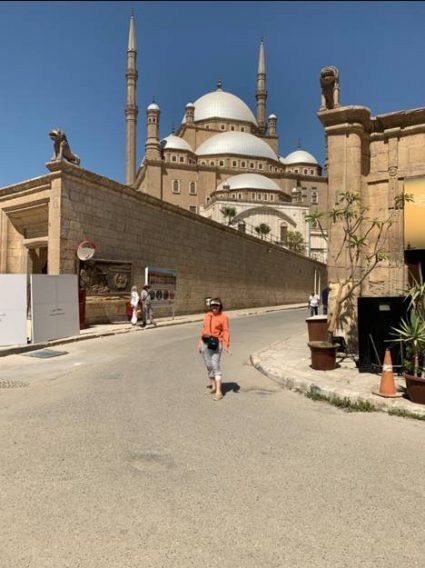
Inside the grounds was the Citadel Prison which appeared to be a really grim place. While there were multiple prisons on the grounds, the current one was built in 1874 AD.
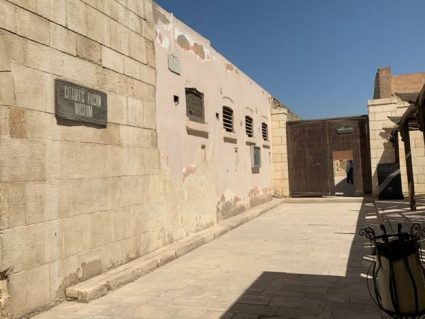
The view from the top of the Citadel gives a sense of the immensity of Cairo and the number of mosques in the surrounding area.
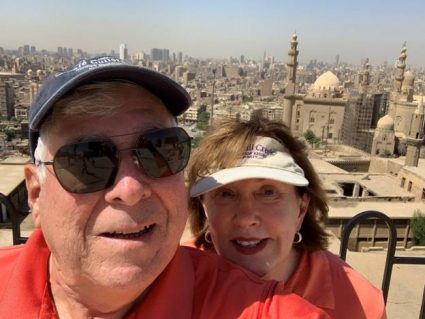
Our next stop was at the Robert Grenville Gayer-Anderson House. He was a British doctor who came to Egypt in 1907 and was an obsessive collector. His house is a museum collection of artifacts from many countries of the world.
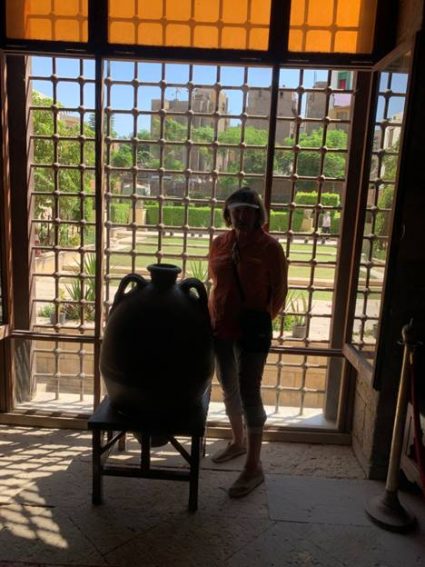
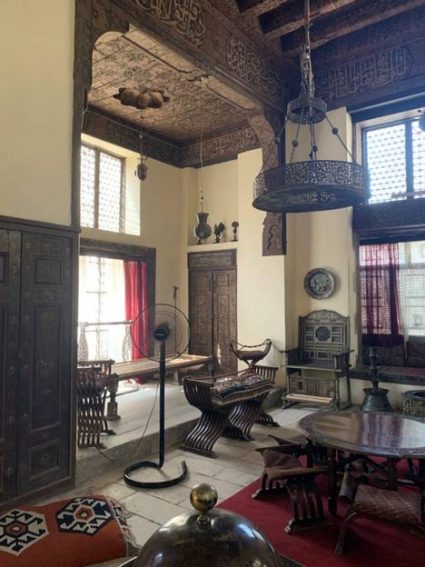
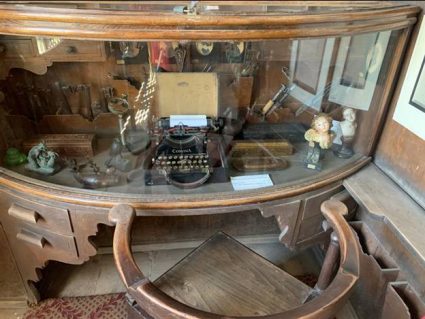
Thursday September 28, 2023
We met our guide, Mahmoud, for the first time this morning. We boarded our van with one other couple and drove to the Great Pyramid of Giza.
The Great Pyramid of Giza is the largest Egyptian pyramid and served as the tomb of Pharaoh Khufu, who ruled during the Fourth Dynasty of the Old Kingdom. Built in the early 26th century BC, over a period of about 27 years, it is situated at the northern end of the line of the three pyramids at Giza.
The Great Pyramid was the world’s tallest human-made structure for more than 3,800 years. Over time, most of the smooth white limestone casing was removed, which lowered the pyramid’s height.
It was built by quarrying an estimated 2.3 million large blocks, weighing 6 million tons in total. The majority of the stones are not uniform in size or shape, and are only roughly dressed. Blocks of granite from Aswan weighing up to 80 tons were brought by boat for the “King’s Chamber” structure.
There are three known chambers inside of the Great Pyramid. The lowest was cut into the bedrock upon which the pyramid was built but remained unfinished. The so-called Queen’s Chamber and King’s Chamber, which contain a granite sarcophagus, are above ground within the pyramid structure. Many varying scientific and alternative hypotheses attempt to explain the exact construction techniques.
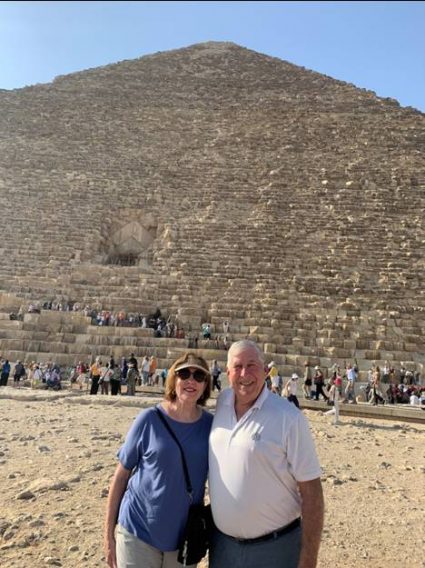
The size of the stones used to build the pyramids is staggering and they were moved many miles to be used in construction.
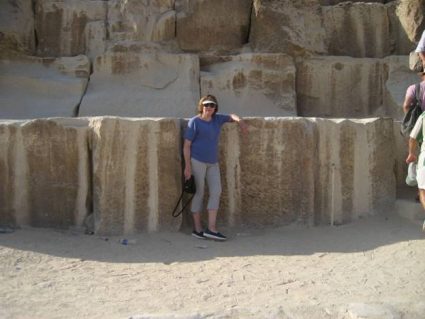
People are dwarfed by the size and scope of these pyramids, and they were built over 4,500 years ago.
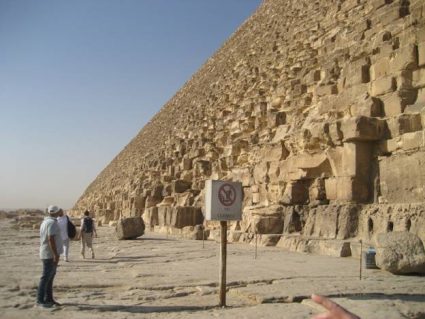
Our visit was early in the morning and the tourist busses were already lined up.
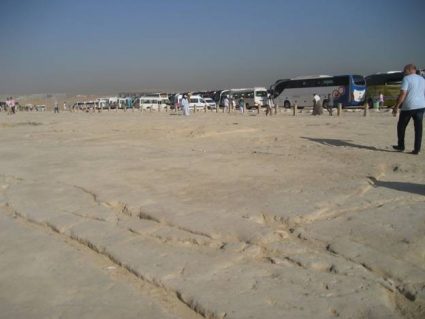
Next, we were off to visit the Great Sphinx.
The Great Sphinx of Giza is a limestone statue of a reclining sphinx, a mythical creature with the head of a human and the body of a lion. Facing directly from west to east, it stands on the Giza Plateau on the west bank of the Nile in Giza. The face of the Sphinx appears to represent the pharaoh Khafre. The original shape of the Sphinx was cut from the bedrock and has since been restored with layers of limestone blocks.
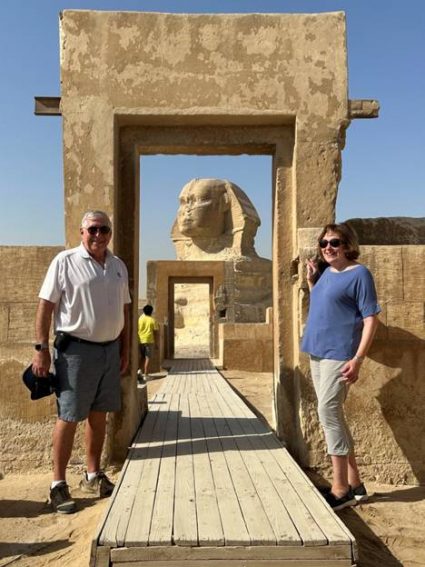
Only four times a day, and for an extra fee, visitors allowed to go down to the sphinx and tour between the paws. Unfortunately, they don’t allow pictures to be taken between the paws. However, our Egyptologist managed a selfie while we were tiny specks walking around the back of the sphinx.
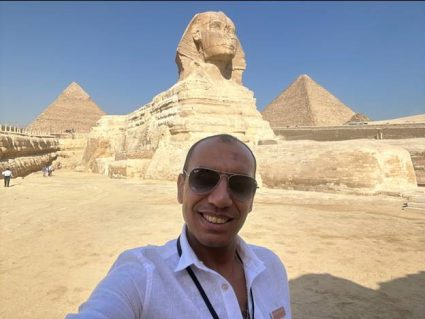
This was Doug and Jan, the only other couple in our group for the first 5 days.
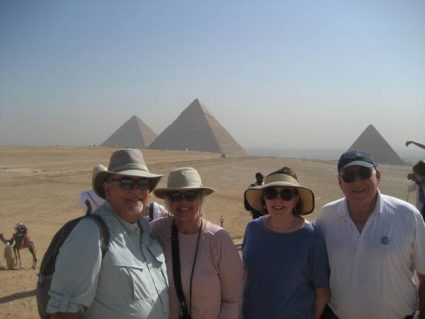
Next up was a camel ride. Doug and Jan got on first.
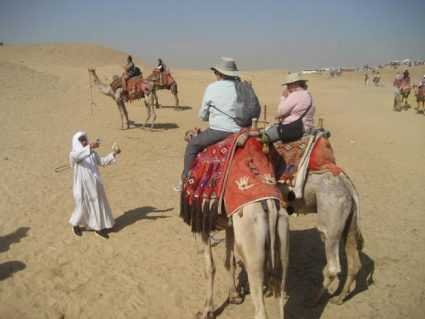
Then they got me on.
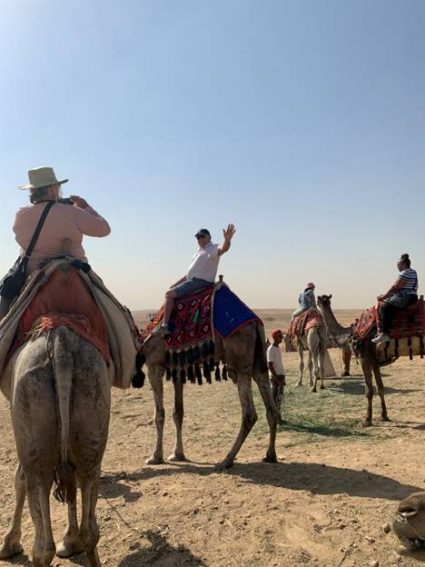
…and we were off.
Following the camel ride, we stopped briefly at a cotton goods store for some shopping and then stopped for lunch.
After lunch we drove to the Colossus of Ramesses II and the beautiful Alabaster Sphinx.
The Statue is a 3,200-year-old figure of Ramesses II, depicting him standing. It was discovered in 1820 by Giovanni Battista Caviglia at the Great Temple of Ptah near Memphis, Egypt. It is made from limestone and weighs 83 tons. This statue was built to celebrate the victory over the Hittites in the Battle of Kadesh in 1274 B.C.
Ramesses II is regarded as one of the greatest and most powerful pharaohs in Egyptian history. During his remarkable reign of around 66 years, he accomplished many things. He is credited with fathering 90 children. He fought multiple wars and achieved one of the earliest peace treaties in world history.
He built extensively throughout Egypt, building cities, temples and monuments such as his administrative capital of Pi-Ramesses in the Nile Delta, the Abu Simbel temples in Nubia and the Ptah Temple in Memphis.
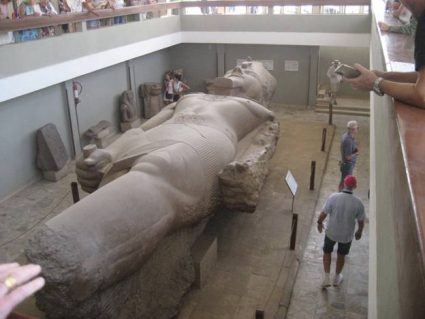
From here we drove to the Step Pyramid Complex built by King Netjerykhet (also known as Kjoser) about 2700 BC. This is the largest known pyramidal funerary complex in Saqqara. It is considered the precursor to the Great Pyramids.
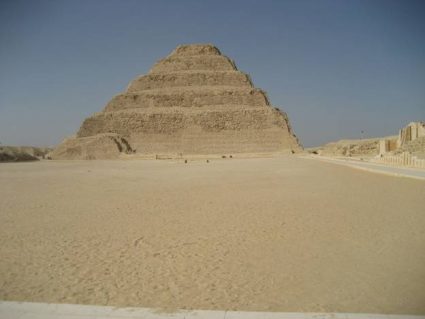
The Step Pyramid was entered for the first time in 1821 by Heinrich von Minutoli.
The Step Pyramid Complex includes ten different architectural elements including the Court of Columns:
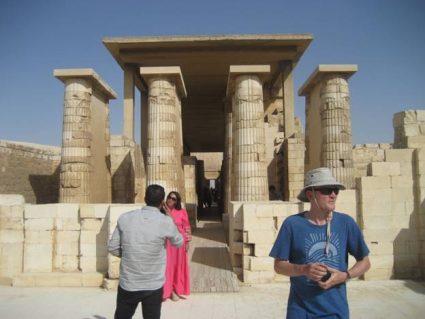
The underground structure of this complex has only partially been explored.
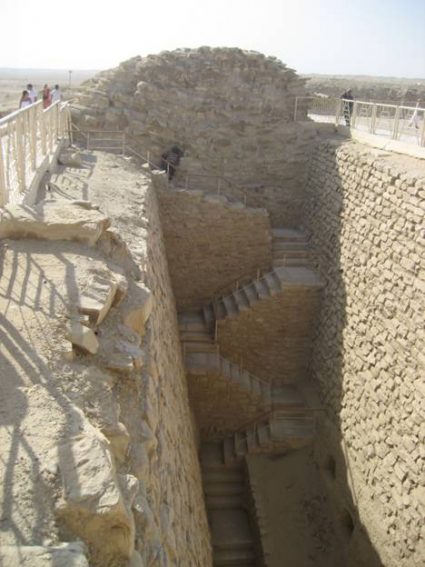
From there we drove to the Tomb of Mehu recently opened to visitors for the first time in 80 years. The 4,000-year-old Tomb of Mehu belonged to a high-ranking official. Archeologists say its colorful wall decorations shed light on how Egyptians lived more than a thousand years before the pyramids were constructed.
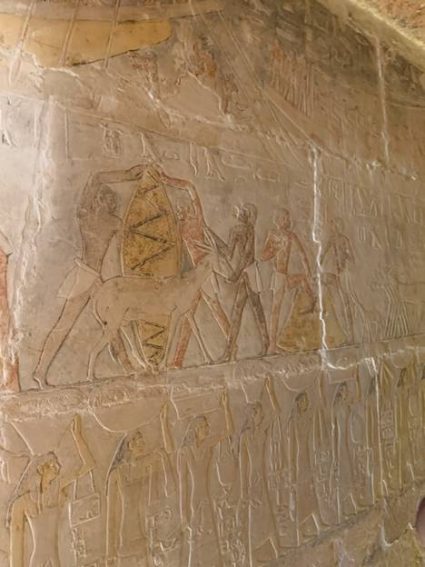
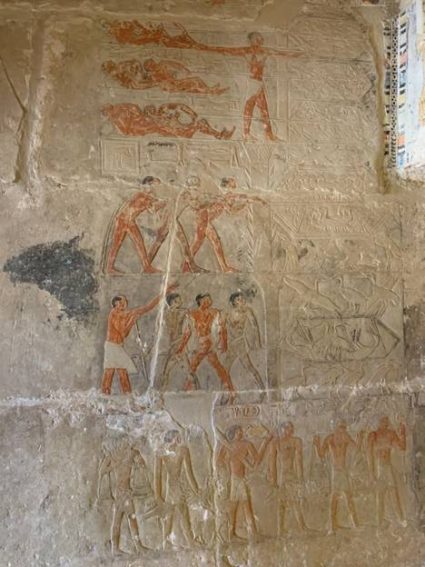
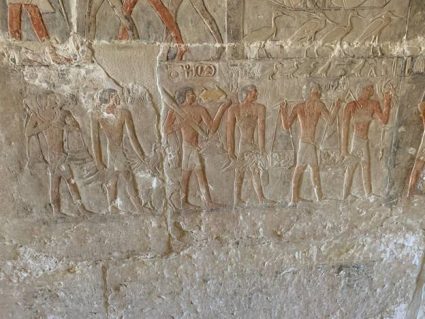
Friday September 29, 2023
Our first stop this morning was to the Refaai Mosque near the Citadel.
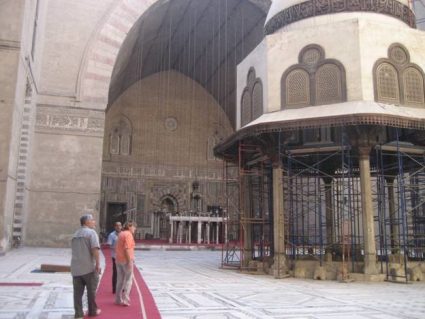
This mosque was purpose-built as a mausoleum for Egyptian royalty. Our guide demonstrated the fantastic acoustics in the design. By standing in the small alcove and speaking, his voice carried throughout the complex.
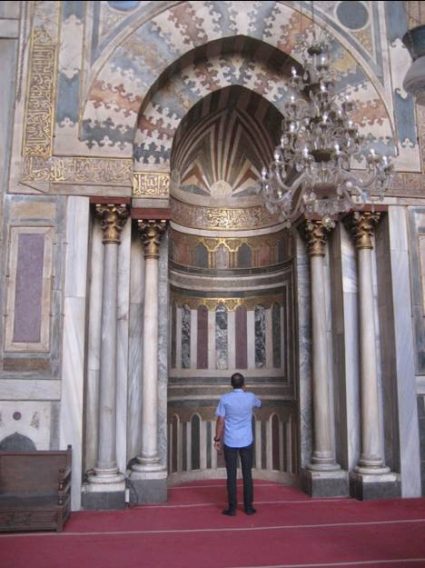
Our guide was quick to state that Egypt is very accepting of all religions. While 94.6% of the population is Muslim, a small percentage is Coptic Christian and less than one percent is Jewish.
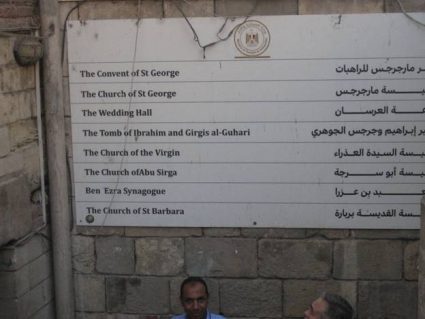
We visited the Cavern Church for a look inside one of the Coptic Christian institutions.
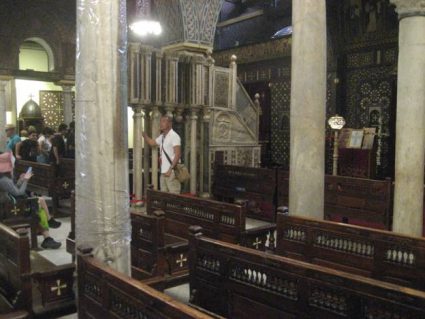
Following a stop for lunch, we continued to Old Cairo and a visit to the Egyptian Museum of Antiquities.
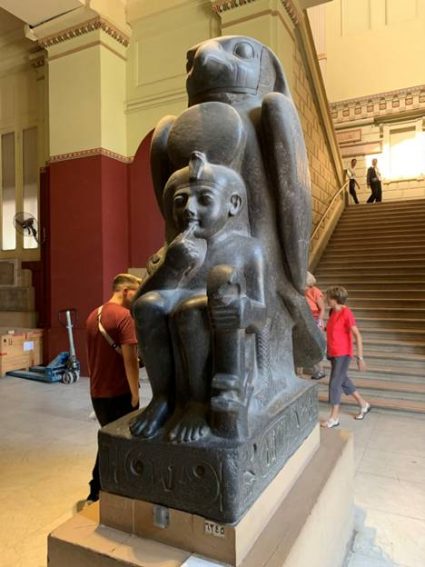
A close up of the cartouche at the bottom tells a story including the name of the person represented.
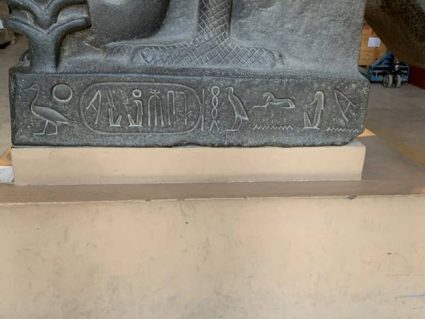
The Canopic Jars of Kiya were found in a side room of the mysterious tomb 55. The jars contain the viscera of a Nubian princess or queen.
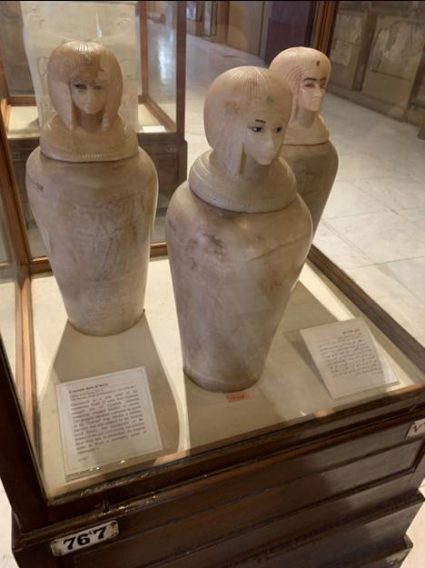
Saturday September 30, 2023
This morning we checked out of the Kempinski Hotel for a two hour bus ride to the ancient port of Alexandria, Egypt.
Upon arrival, we enjoyed lunch overlooking a harbor on the Mediterranean.
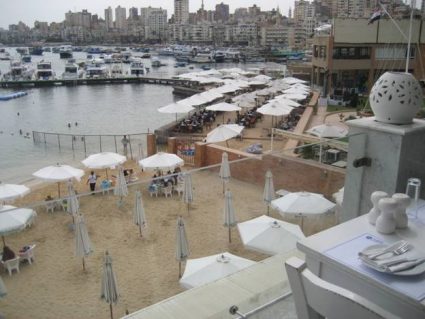
The seafood lunch, served on a shell, was absolutely delicious.

Following lunch, we were bused to the Royal Library of Alexandria.
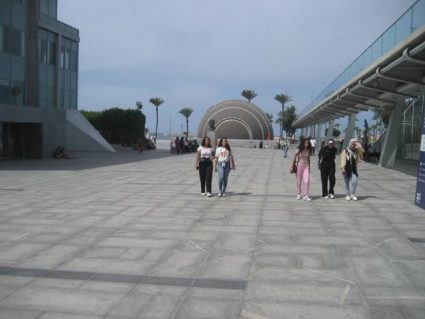
The library is shaped like a giant discus embedded in the ground. Inside, its main reading room can hold 8 million books and accommodate 2,500 people.
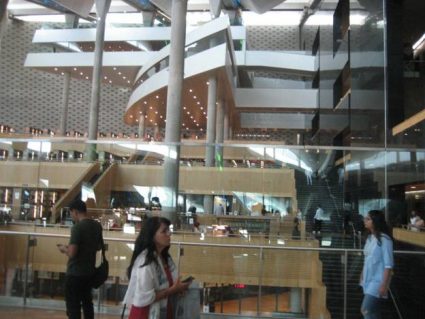
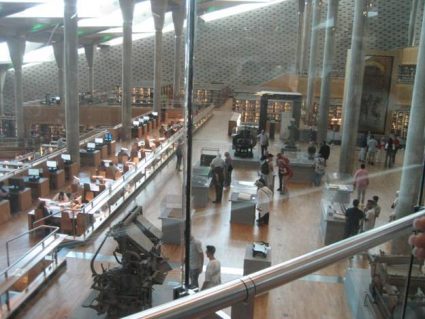
We then checked into the Four Seasons Hotel in Alexandria. This is the view of the Mediterranean from our balcony.
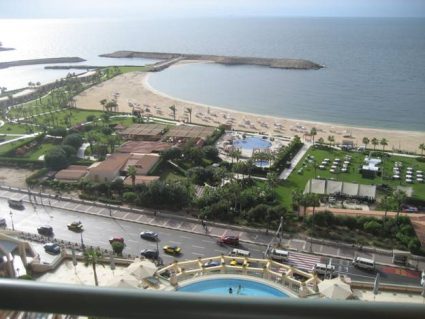
Of course, Pat focused quickly on the pool.
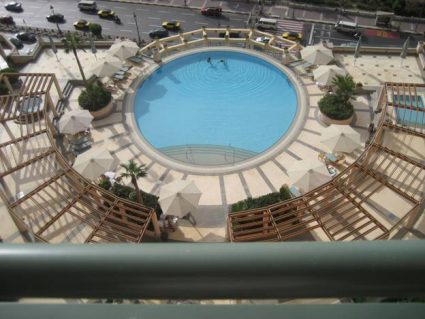
…and we were blessed with a beautiful sunset over the Mediterranean.
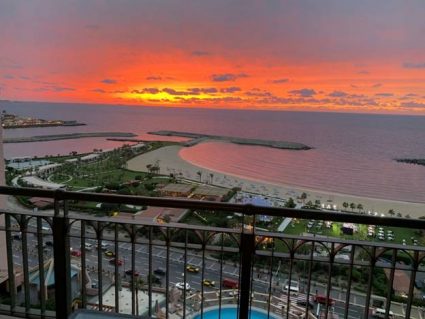
Sunday, October 1, 2023
Today’s tour began with a visit to the Catacombs of Kom El Shuqafa. Discovered in 1900, this vast complex of rock-cut tombs was used for nearly 200 years starting in the second century AD.
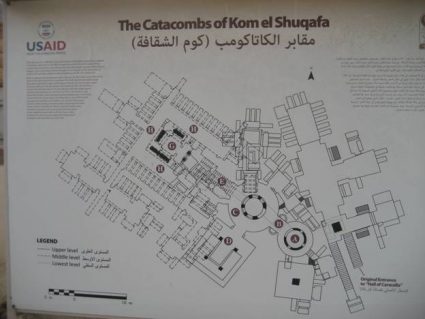
We walked down hundreds of circular steps to enter the catacombs.
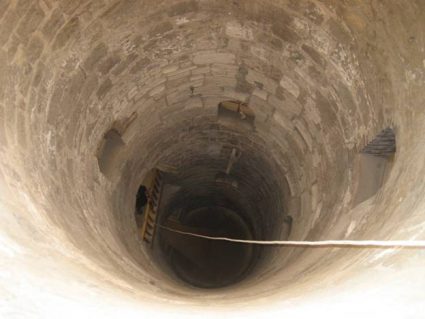
Our traveling friends look through a porthole on the way to the bottom.
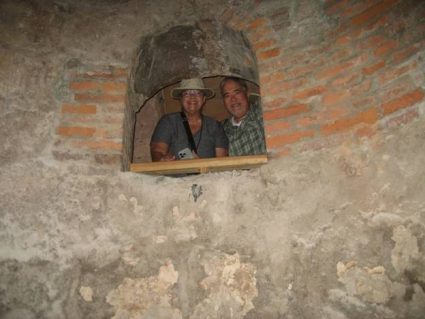
At the bottom are the catacombs where bodies were buried. All of these tombs have been ransacked and the artifacts stolen long ago.
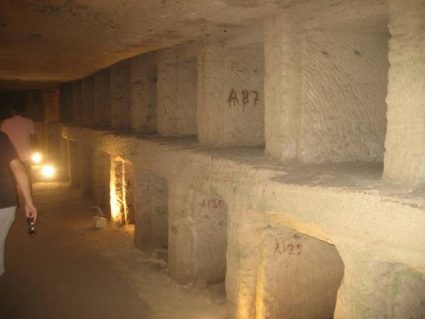
The following images are just some of the art found in these catacombs.
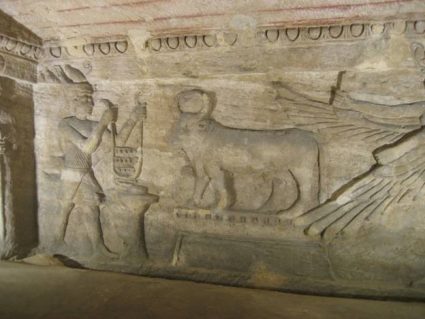
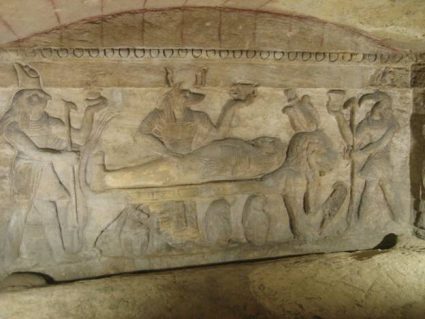
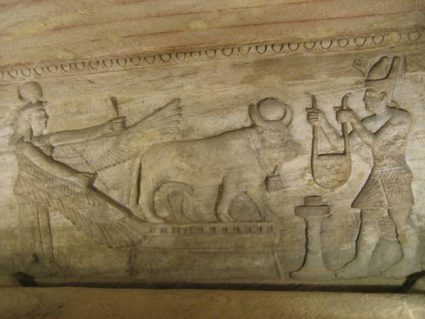
After climbing back up all of those steps, we returned to our van and drove to the Temple of the God Serapis.
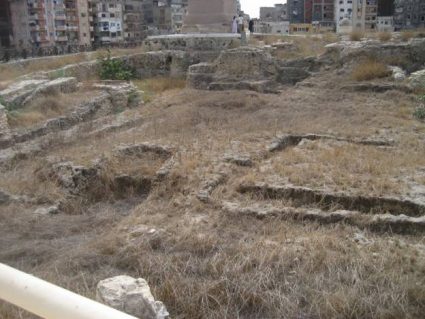
This is the site of Pompeys Pillar.
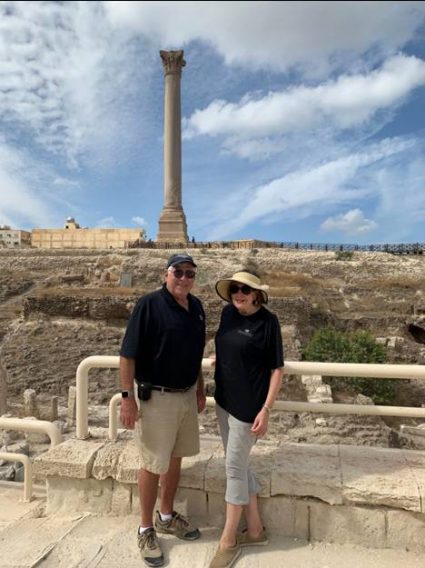
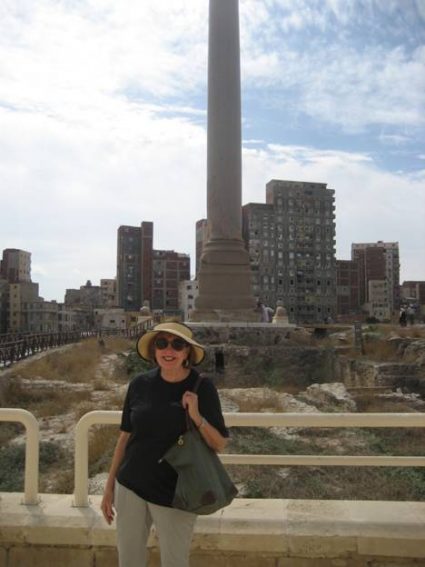
Next we drove to the Roman Theater, Kom El-Dikka.
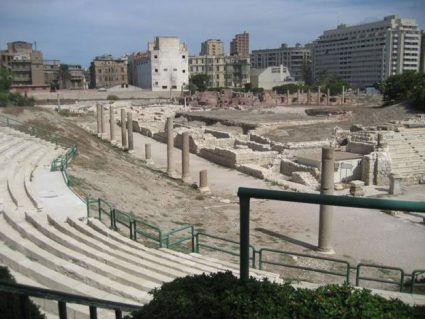
This fourth century AD building was in use for close to 300 years. In the sixth century AD the building was fitted with a horseshoe-shaped auditorium and covered with a large dome. The building was apparently used for chariot races and other public assemblies.
In one corner was the Villa of the Birds.
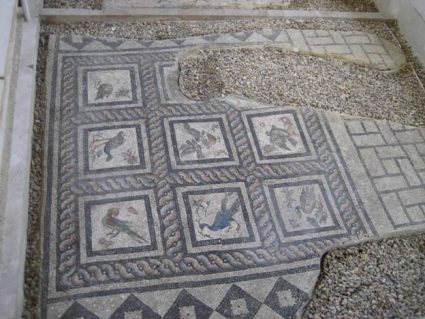
Most of the villa’s mosaics were laid during the reign of Hadrian (AD 117-138). The building was destroyed by fire in the late third century. Conservators cleaned the fire-blackened mosaics; repaired breaks caused by collapsing walls; and restored missing portions.
We then returned to our van for the ride to lunch. This time we were in Alexandria rush hour. Note the person calmly walking among the cars to cross the street. This was unbelievably common throughout Egypt.
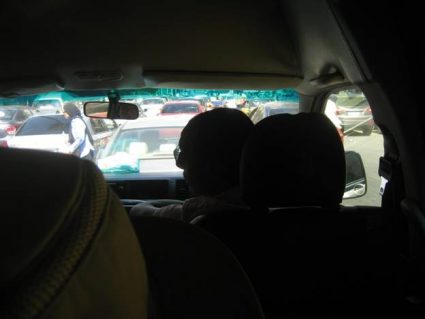
Lunch was back at the San Giovanni Hotel and Restaurant. Note that there was a McDonald’s across the street.
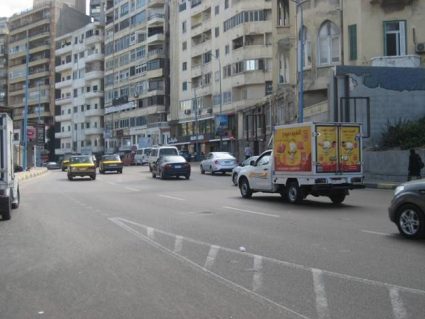
Monday October 2, 2023
Following breakfast, we drove the two hours back to the Kempinski Nile Hotel for a relaxing afternoon. One of the young girls staying at the hotel put on this mermaid suit and did a little swimming.
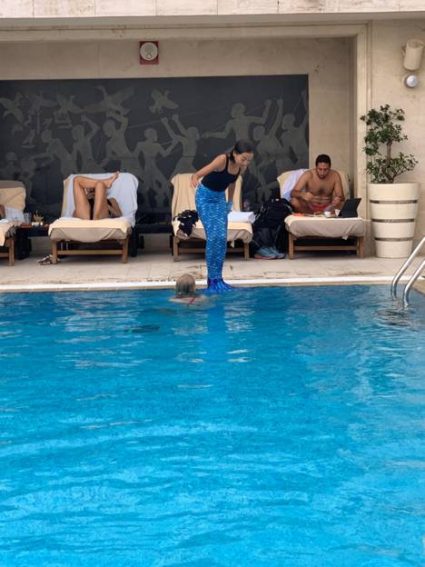
Tuesday, October 3, 2023
We were awakened with a 4:30 am wake-up call to catch a flight to Luxor. From the airport we were bused to the Nile and boarded The Obroi Zahara which was to be our home for the next four days.
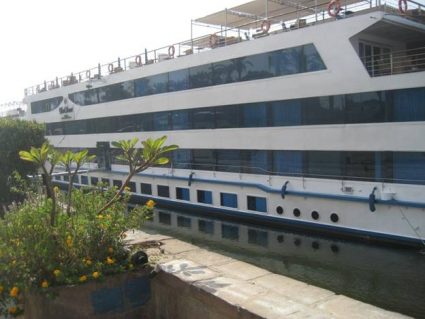
Following lunch aboard, we got in our van to visit the Karnak Temple. This is one of the most celebrated sites of antiquity. The layout is reflected in this model.
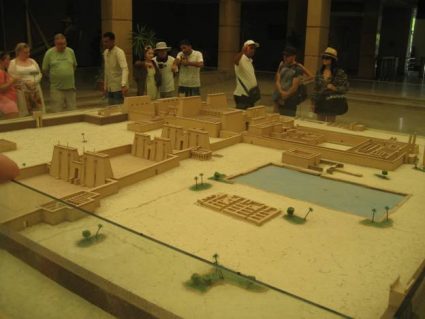
Construction at the complex began during the reign of Senusret I (reigned 1971–1926 BC) in the Middle Kingdom (c. 2000–1700 BCE) and continued into the Ptolemaic Kingdom (305–30 BC).
It consists of four main parts, of which only the largest is currently open to the public. The term Karnak often is understood as being the Precinct of Amun-Re only because this is the only part most visitors see.
Approximately thirty pharaohs contributed to the buildings, enabling it to reach a size, complexity, and diversity not seen elsewhere. Few of the individual features of Karnak are unique, but the size and number of features are vast. The deities represented range from some of the earliest worshipped to those worshipped much later in the history of the Ancient Egyptian culture.
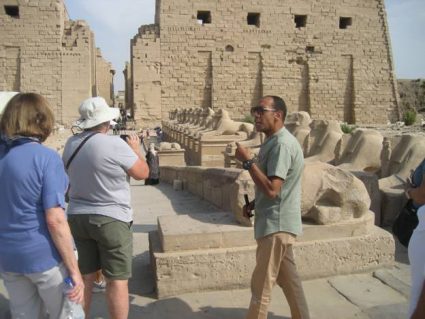
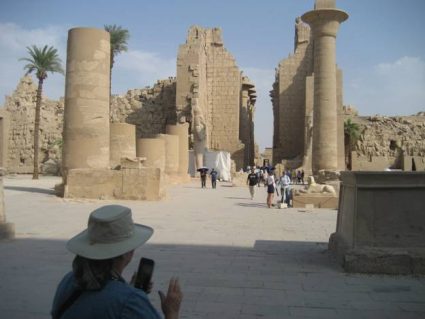
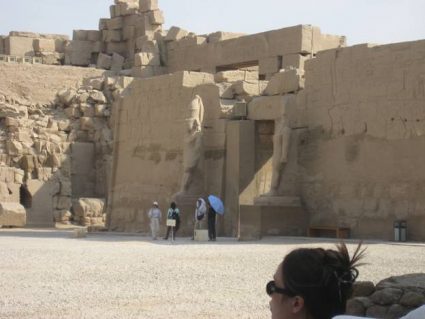
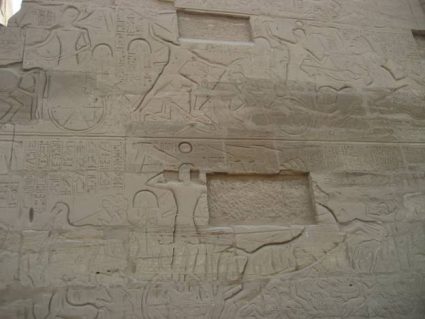
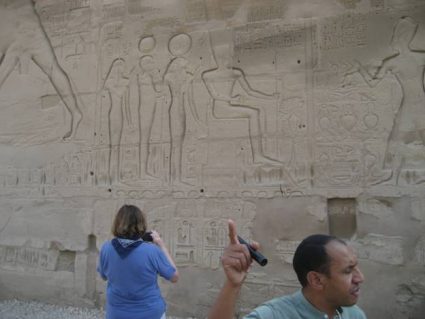
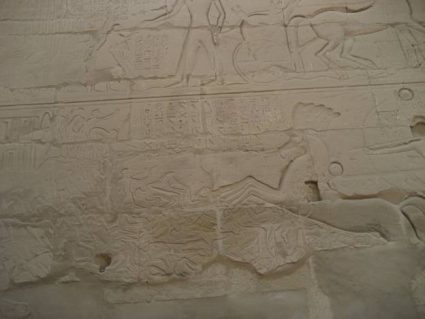
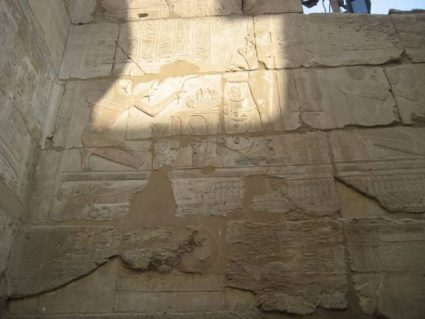
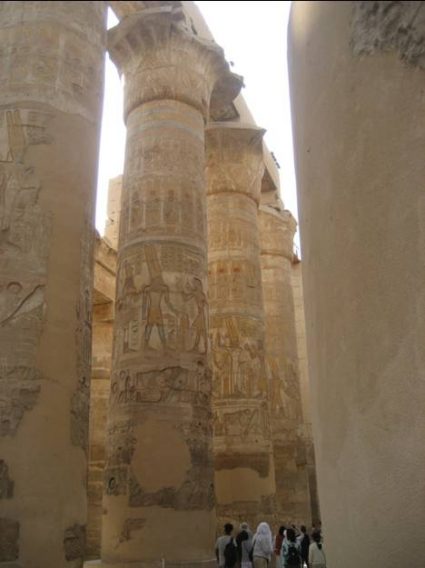
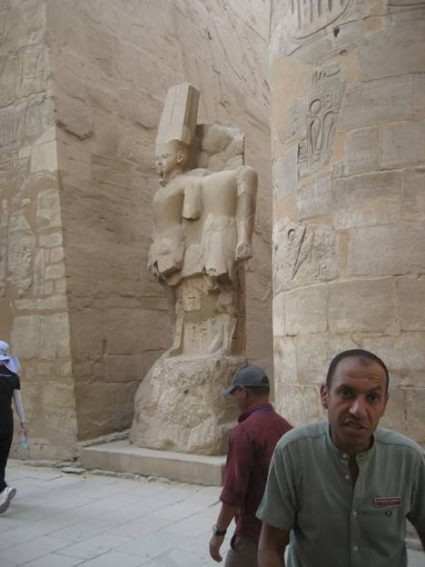
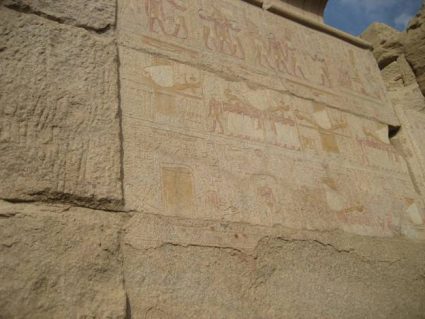
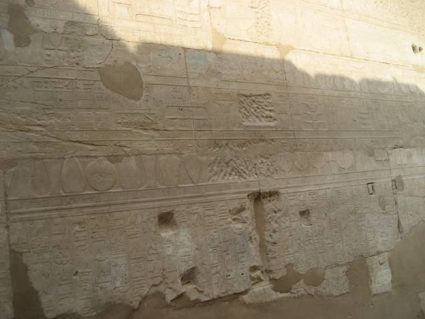
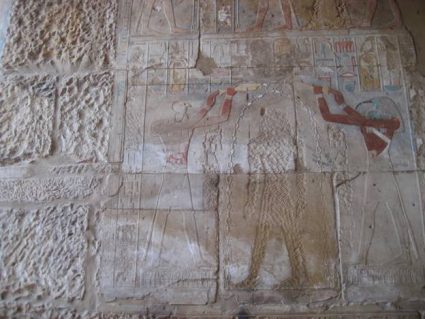
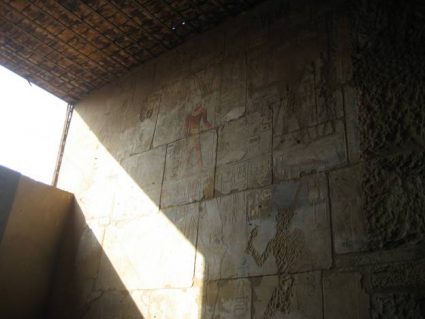
We then went to the nearby Luxor Temple.
The scale, magnificence and sheer number of monuments in Luxor reflect this city’s importance throughout Egyptian history. Called Waset by the ancient Egyptians, it became known by its Greek name of Thebes. After the Arab Conquest the area was called Luxor.
While most people lived in the city on the east bank of the Nile, the Theban west bank, was mostly reserved or the dead and funerary practices. The west bank holds many mortuary temples. The most famous of which include Hatshepsut’s in Deir al-Bahari, Ramesses II’s Ramesseum, and Rameses III’s temple in Medinet Habu.
Here is Pat at the entrance to the Temple.
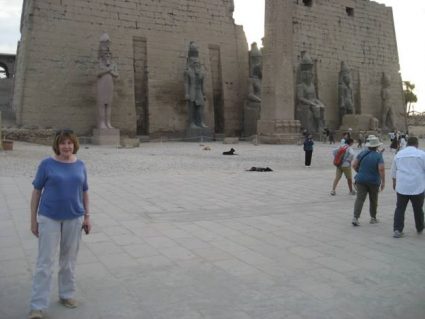
Below is called The Avenue of the Sphinxes.
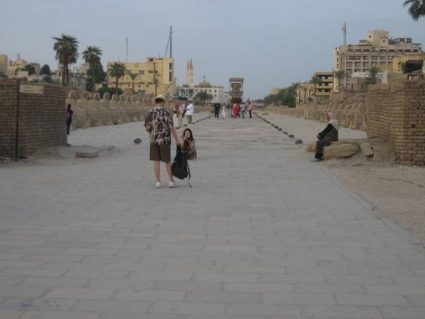
The functioning mosque in the Ramesses II Court makes this temple one of the rare sites in Egypt that has been a place of continuous worship since at least 2000 BC.
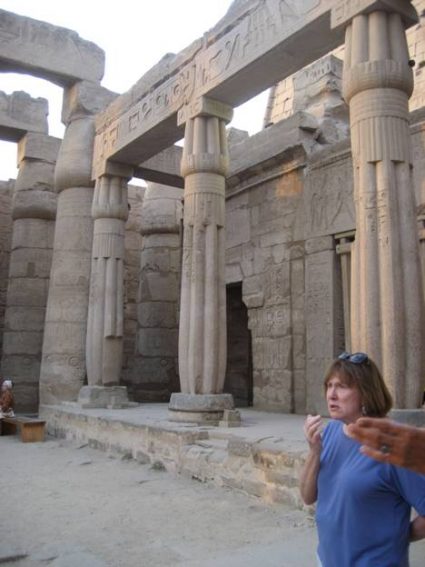
The Luxor Temple was largely the product of two kings, Ramesses II (1290-1224 BC) and Amenhotep III (1391-1353 BC).
The pylon form was a three-dimensional representation of the hieroglyph Akhet, the mountains of the horizon, between which the sun rose and set each day.
The fronts were carved with the largest version of Ramesses II’s Kadesh battle narrative ever executed. His confrontation between the Egyptian and Hittite empires resulted in the first recorded peace treaty between those two great nations. The graphic below shows the two kings at peace.
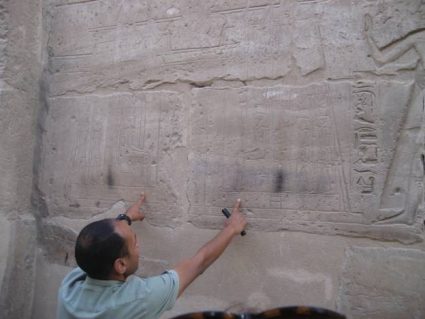
Egypt was a province of the Roman Empire from 29 BC until the Arab conquest in 641 AD. During this period many images of gods were scratched out and defaced.
Inside, there is a most unusual depiction of a penis ejecting semen.
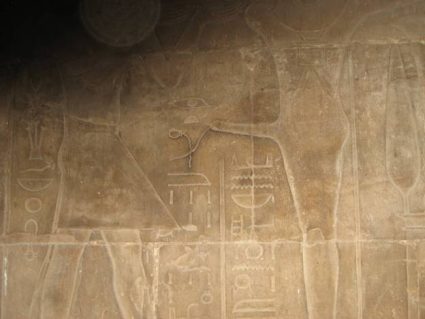
Following this visit, we returned to the Oberoi Zahra for cocktails and dinner. From the photo below you can see that while we were able to dock directly to the shore, others were required to stack their boats for the night.
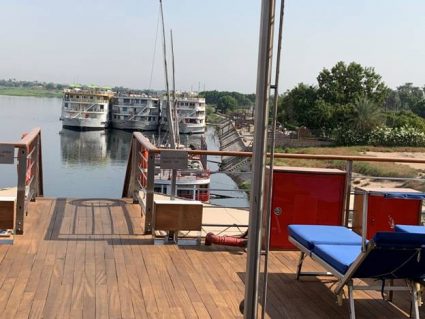
Wednesday October 4, 2023
After breakfast aboard the Oberoi Zahra, we boarded our van to the West Bank where 64 ancient Egyptian rulers are buried in the Valley of the Kings.
As we approached our first destination, the sun was just rising and we came upon a hot air balloon festival.
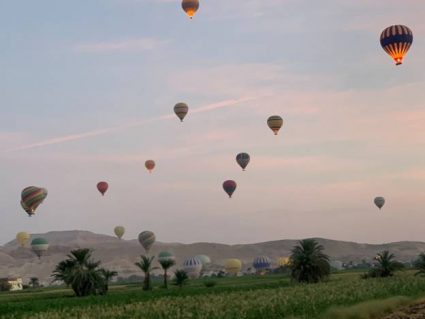
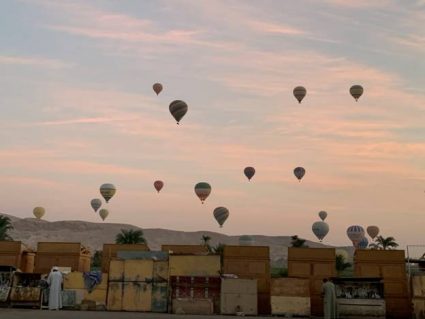
These folks were getting a bird’s eye view of the sunrise over the Valley of the Kings.
Our first stop was to the Deir el-Medina or remnants of the workers homes. These were the accommodations for the artists, artisans and workmen who were engaged in the cutting and decorating of the tombs in the Valleys of the Kings and Queens during the New Kingdom (c. 1500 to 1100 BC). We were told that the workers were given very nice residences but were never allowed to leave.
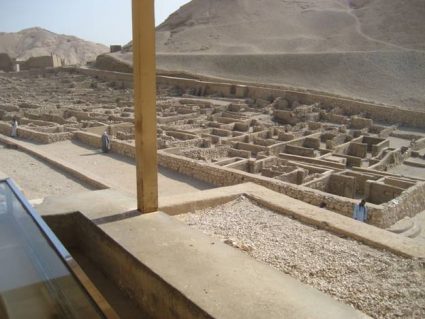
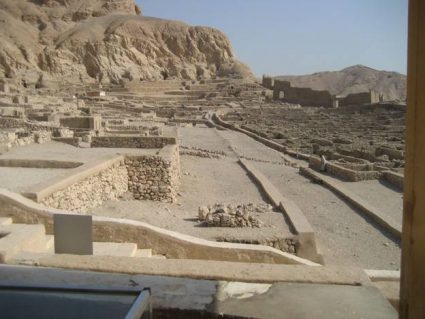
Inside the main building was a clear plastic model of the Valley.
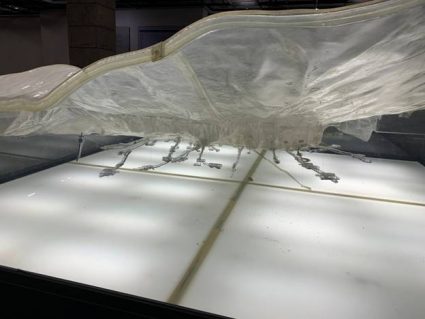
This provided a fascinating three-dimension look at the work that archeologists had done to excavate the various tombs. There were also two maps showing the location of the major tombs found in the Valley of the Kings.
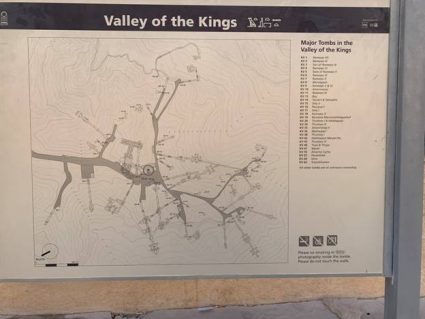
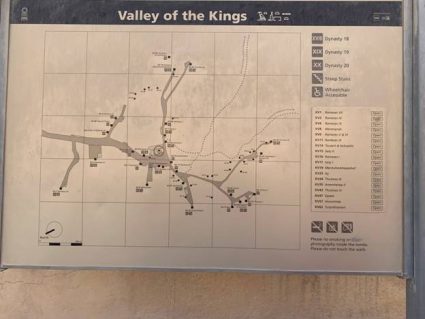
With the 2005 discovery of a new chamber and the 2008 discovery of two further tomb entrances, the Valley of the Kings is known to contain 65 tombs and chambers, ranging in size from the simple pit that is to the complex tomb which alone has over 120 chambers for the sons of Ramesses II. It was the principal burial place for the New Kingdom’s major royal figures as well as a number of privileged nobles. The royal tombs are decorated with traditional scenes from Egyptian mythology and reveal clues to the period’s funerary practices and afterlife beliefs. Almost all of the tombs seem to have been opened and robbed in antiquity, but they still give an idea of the opulence and power of Egypt’s pharaohs.
We first entered the tomb of Tutankhamen.
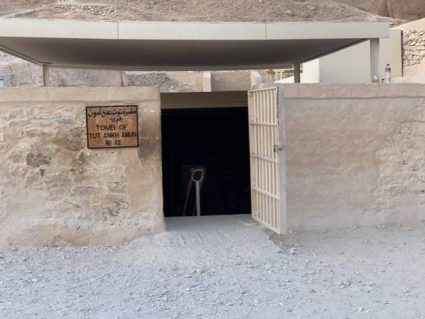
This was the only nearly intact royal burial to be found in the Valley of the Kings. Below is the story of Howard Carter and Lord Carnarvon and the long history of finding and opening this tomb.
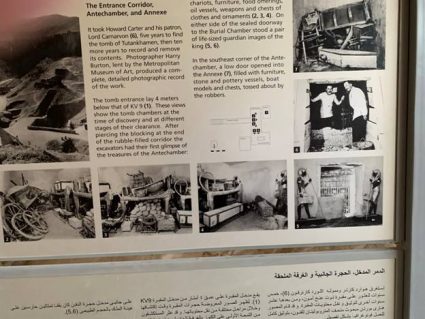
The king’s badly preserved remains, adorned with amulets and jewelry, rested in the gold coffin with an inlaid gold mask over the head. Another door opened into the treasury, dominated by the Anubis jackal and an elaborate gilded shrine that held the calcite canopic chest protected by four goddesses.
Tutankhamen ruled from 1333 to 1323 BC and died at age 19. With his early death an existing tomb was hastily adapted for his burial. Now over 3,300 years old, the paintings have remarkably little loss of the original colors.
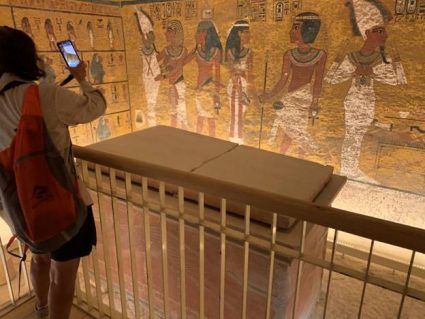
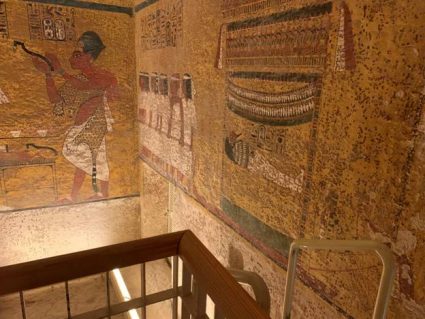
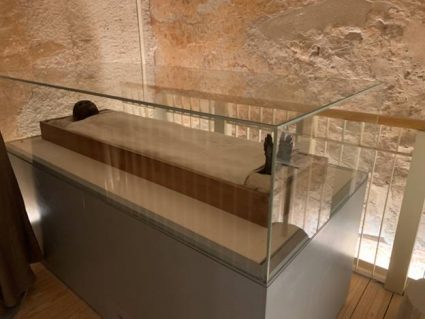
Next we entered the tomb of Rameses V and VI. The tomb was begun for Rameses V but taken over and completed for Rameses VI. This tomb was beautifully decorated. Carved decoration tells of the afterlife of the king through symbolism connecting him with the sun god Re and with Osiris.
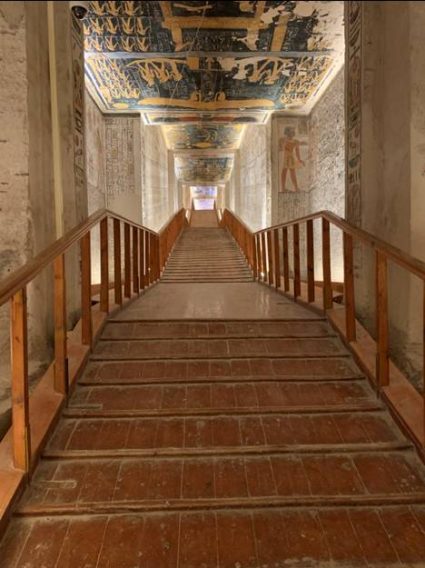
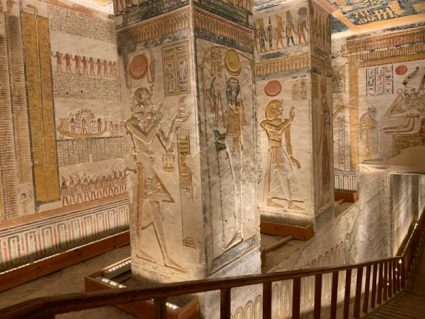
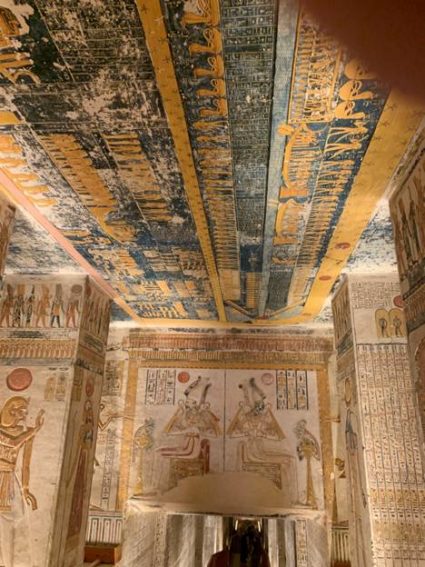
Our small group had been joined this morning by Janice and Greta.
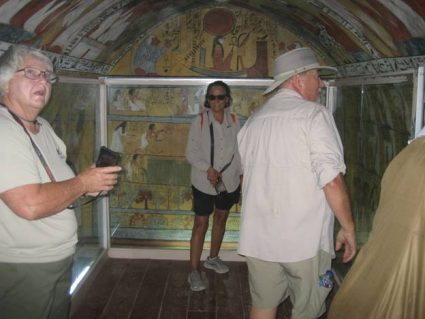
We also visited the tomb of Queen Hatsheput.
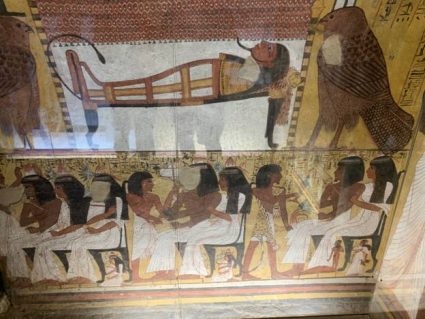
Back in our van we drove to the Colossi of Memnon.
The Colossi of Memnon are two massive stone statues of the Pharaoh Amenhotep III, which stand at the front of the ruined Mortuary Temple of Amenhotep III, the largest temple in the Theban Neropolis. They have stood since 1350 BC and were well known to ancient Greeks and Romans.
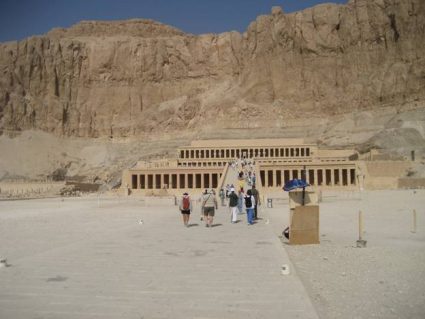
This was clearly a work in process. Signs of ongoing digging were everywhere.
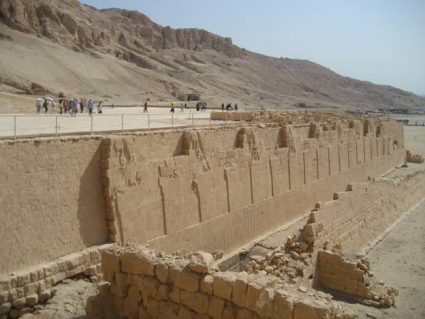
We returned to the Oberoi Zahra and found that our room had already been made up and we were treated with our first towel pet.
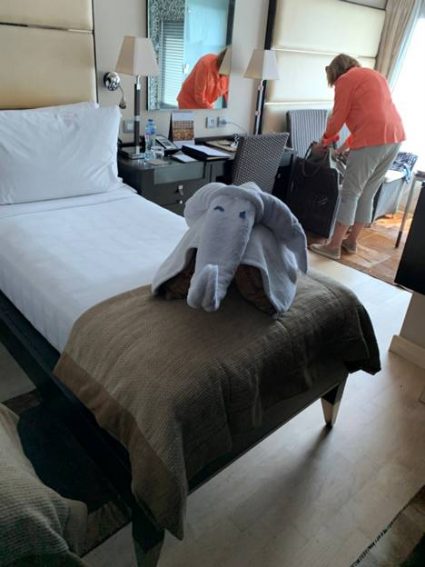
Our boat set off on the Nile to travel further south. Along the way there was very little of interest. In a very dry country, the Nile provides the major source of water for growing anything.
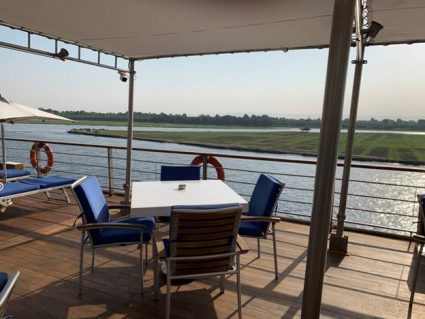
But mostly there were just rocks.
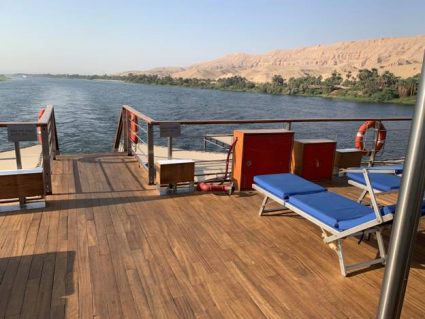
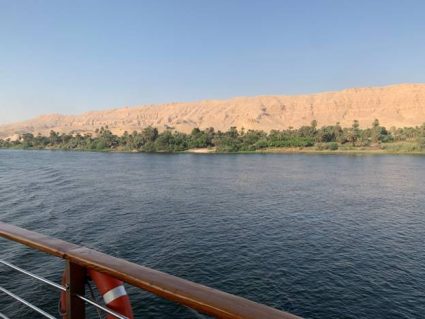
Except for Pat.
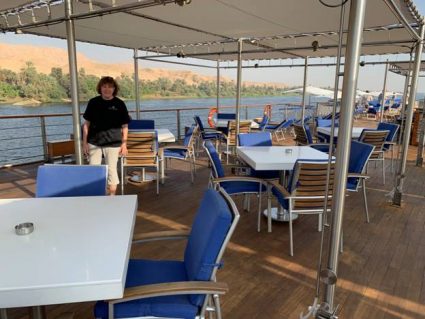
Some aggressive entrepreneurs tied onto the side of our boat and managed to exchange various trinkets for local currency.
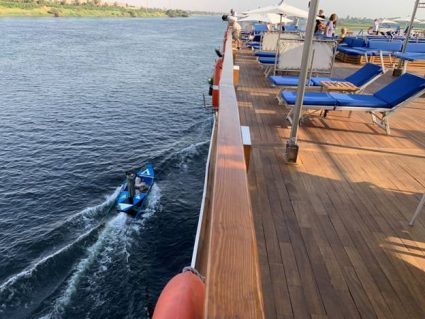
And we had to pass through a lock to raise our boat and continue upstream to the south.
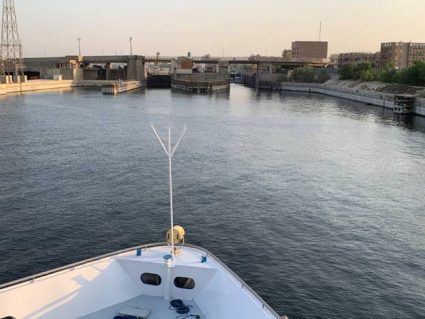
We returned to our rooms to find yet another towel pet.
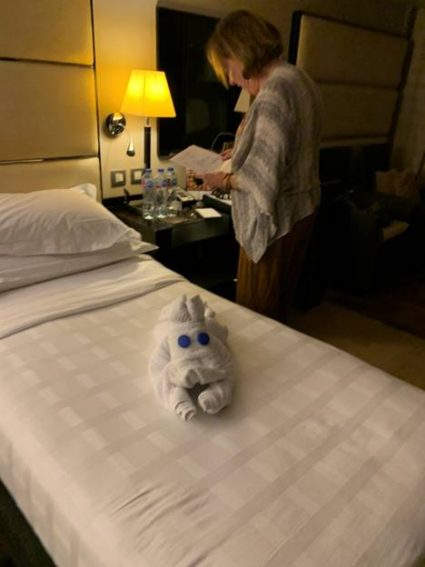
Thursday October 5, 2023
After breakfast we disembarked to visit the Temple of Horus.
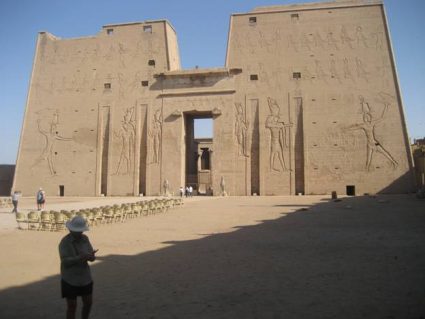
The Temple of Horus at Edfu is a Greco-Roman temple that was dedicated to the god Horus, becoming one of the largest in Ancient Egypt, only behind the Karnak Temple in Luxor, as well as being one of the best preserved in the country.
The Temple of Horus, through its inscriptions on the walls of the temple, provides information about its construction, mythological and religious references and how they lived in Ancient Egypt.
The head gear on the depicted king indicates that he was ruler of both Upper and Lower Egypt.
The entrance of the Temple of Edfu shows us through its giant 37-meter-high pylon, Ptomoleo XII, the last Ptolemaic ruler striking his enemies before the god Horus.
Notice the multiple depictions of arms and hands in the picture below. This is how groups of people were displayed in many of the tombs in Egypt.
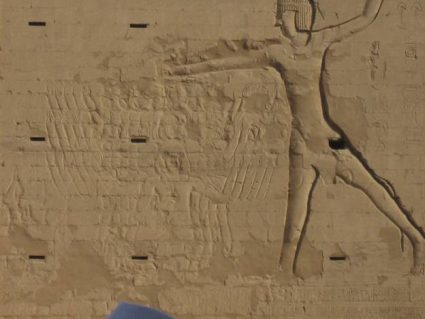
The hypo-style hall of the festivals is the oldest part of the temple and is composed of 12 decorated columns as well as several rooms for offerings, the Chamber of Consecrations where the king or priest dressed for rituals located on the left, and the Library on the right.
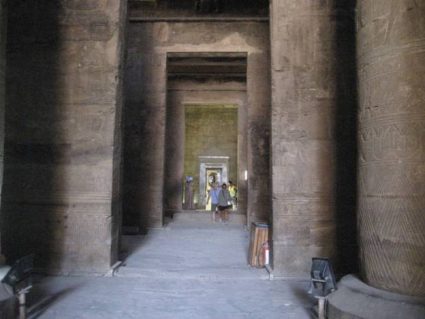
After the central hall is the famous sanctuary of the god Horus, undoubtedly the most sacred part of the temple which was built with black granite and where you can see the table of offerings and the ceremonial boat in which Horus was carried during festivals.
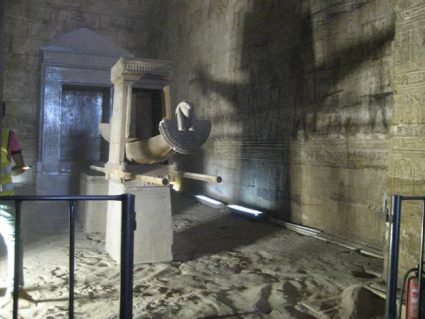
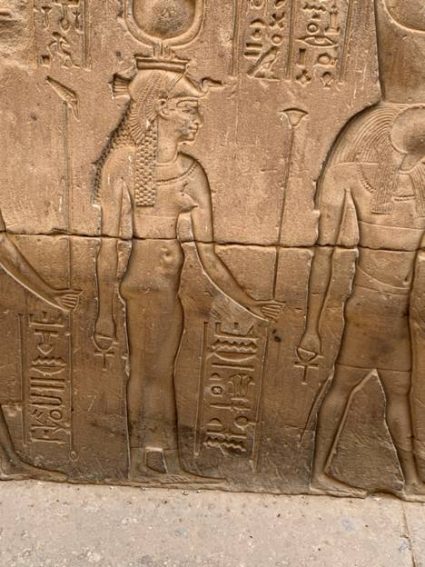
Below Pat is shown with the falcon-headed Horus protecting the queen.
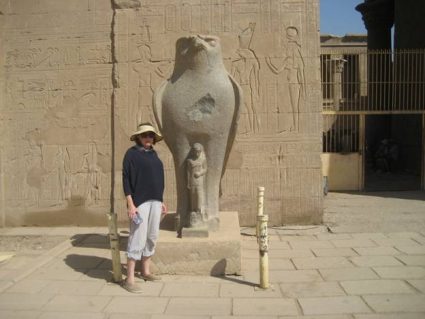
We returned to the boat for lunch and found yet another towel pet in our room.
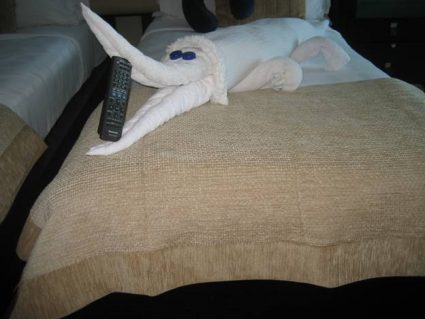
We continued our boat trip south stopping at the Temple of Kom Ombo.
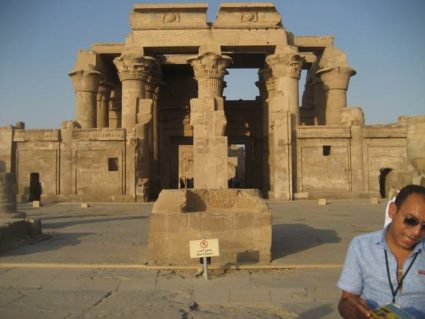
The building is unique because its ‘double’ design which meant that there were courts, halls, sanctuaries and rooms duplicated for two sets of gods. The southern half of the temple was dedicated to the crocodile god Sobek, the god of fertility and creator of the world. Meanwhile, the northern part of the temple was dedicated to the falcon god Horus the Elder, along “with Tasenetnofret (the Good Sister) and Panebtawy (Lord of the Two Lands)”. The temple is atypical because everything is perfectly symmetrical along the main axis.
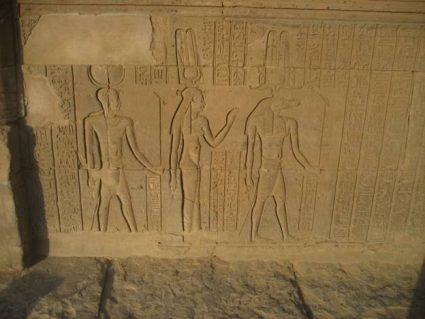
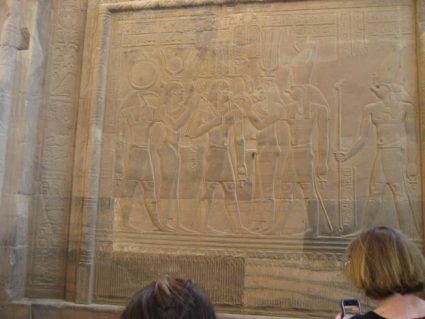
There was a birthing chamber depicted inside showing a queen squatting on a special birthing stool.
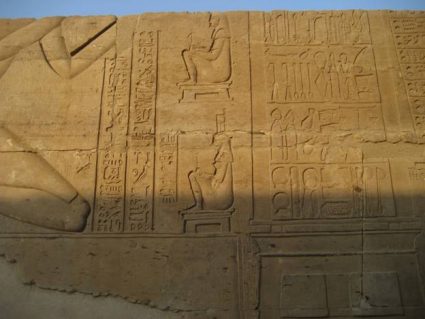
A few of the three hundred crocodile mummies discovered in the vicinity are displayed in The Crocodile Museum.
The god Sobek is depicted either as a crocodile or as a crocodile-headed man wearing a headdress of ram-horns topped by a sun disk and two tall plumes. Crocodiles were both revered and feared. Sobek first appears in the Old Kingdom (ca 2500 BC) and was worshipped until the end of the Roman era (4th century AD).
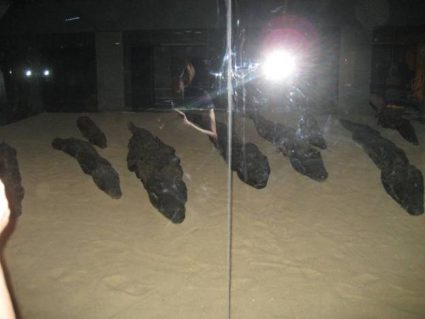
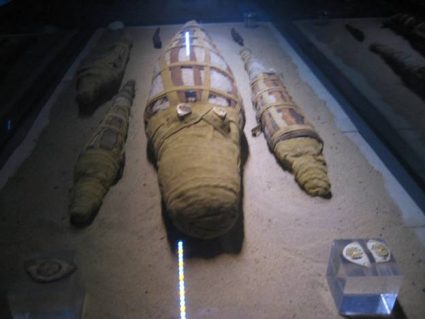
We returned to our boat for the evening.
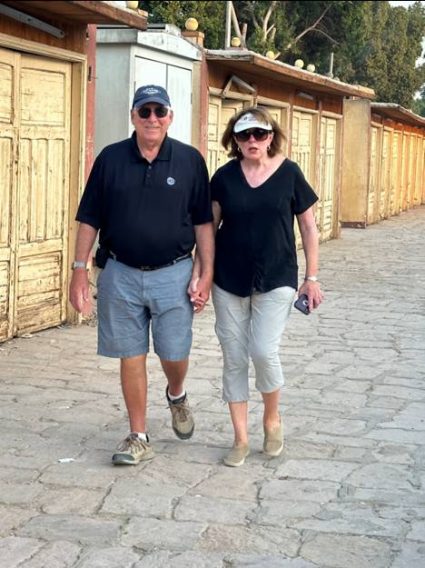
We were just below the first Aswan Dam and this was apparently a popular docking spot as numerous boats were pulling in at about the same time to dock.
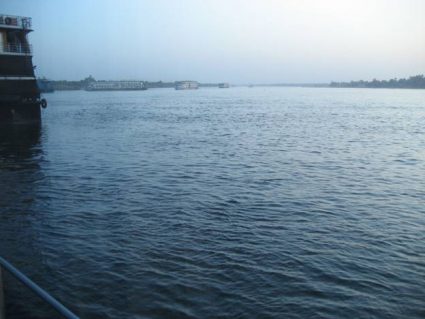
And again we found a towel pet awaiting us in our room.

Friday October 6, 2023
This was a long day of riding in our van to visit the Abu Simbel Temples. After about 2 hours of driving we made a brief stop at a sort of oasis. This was open, un-air conditioned and teaming with flies. But we stretched our legs and used the WC facilities.
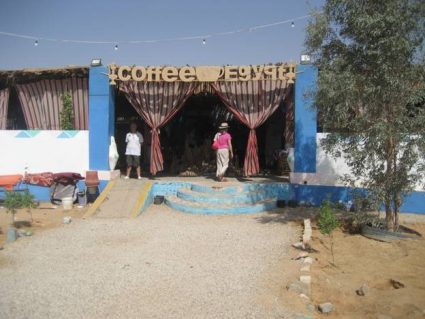
Two hours later the drive put us in an area of the southern Nile called Nubia which is on the border with Sudan. The temples we visited had to be relocated to higher ground with the construction of the new Aswan Dam on Lake Nasser.
The two temples were cut into approximately 1042 massive blocks and reassembled 200 meters to the northwest on ground approximately 65 meters higher.
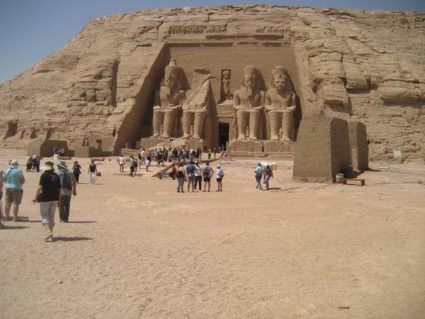
The Great Temple of Abu Simbel was built by King Rameses II during the 19th Dynasty (c. 1279-1213 BC).
Interestingly, the wives of the kings are always depicted as shorter than the knees of the kings.
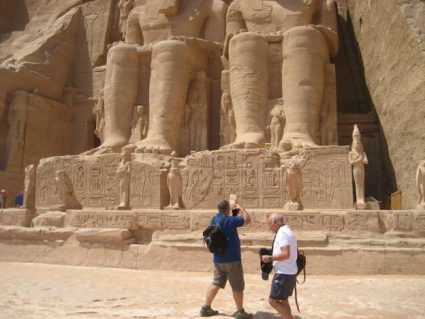
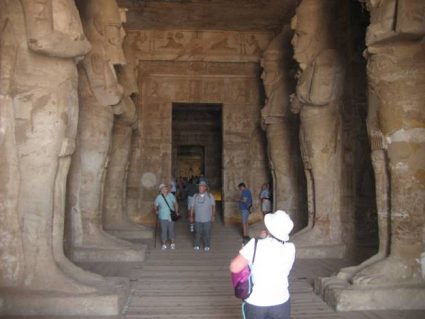
On February 22 and October 22 every year the sun’s rays enter the temple illuminating the faces of Amun-Ra, Rameses II, Ra-Horakhty and Ptah seated at the back wall of the inner sanctuary.
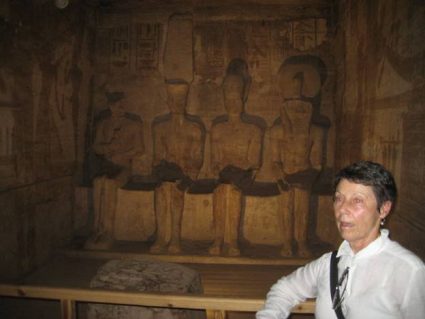
Notice the different headgear depicted on the two kings on the left and right of the inner sanctum entrance.
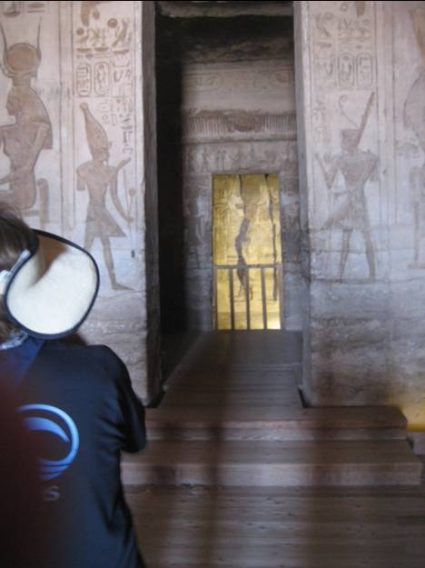
And the head gear on Queen Nefertari.
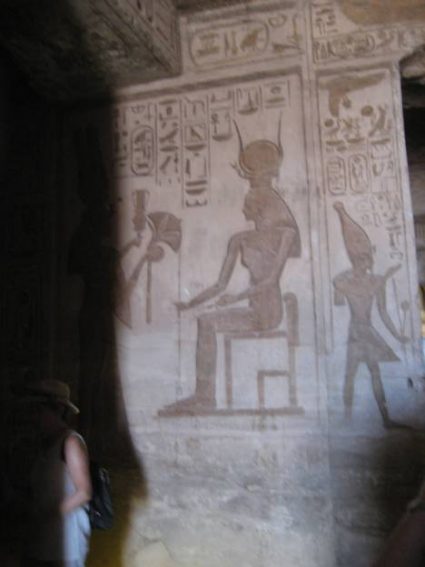
I think Pat found a girlfriend.
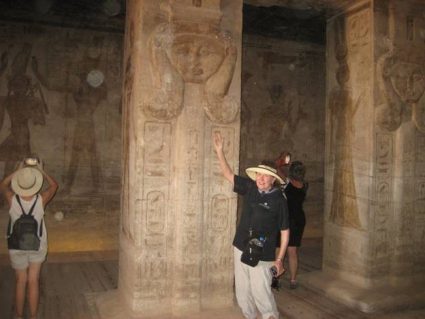
We then were treated to a motorboat ride on Lake Nasser to see the temples from the water.
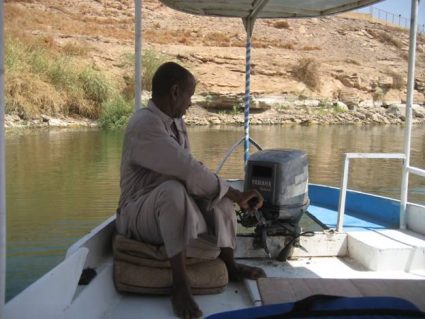
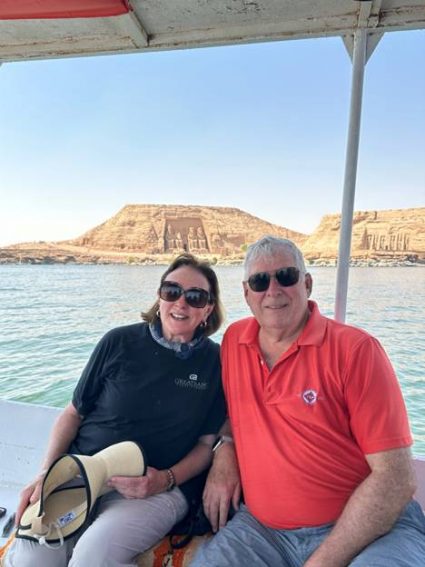
Back on our van, we stopped for lunch at a restaurant where the staff celebrated our guide’s birthday with song and dance.
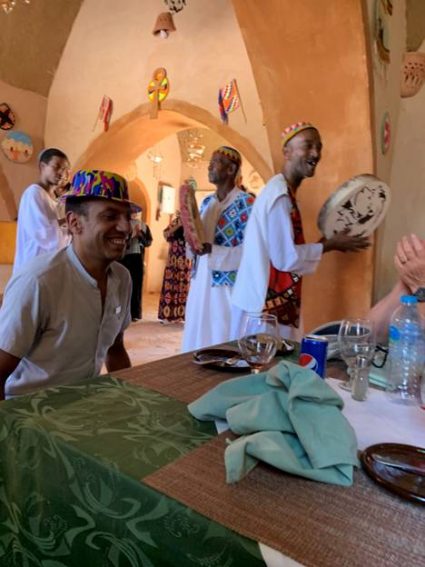
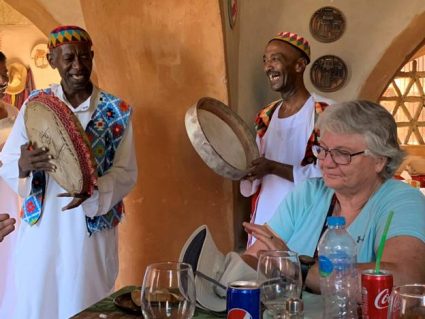
After lunch, we made the 4 hour trip back to the Oberoi Zahra for cocktails and dinner.
Saturday October 7, 2023
This morning we traveled to the High Dam at Aswan. We first stopped at a boat launch where we boarded a small launch to see the Temple of Philae from the waters of Lake Nasser.
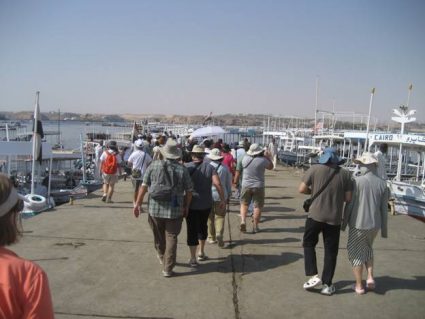
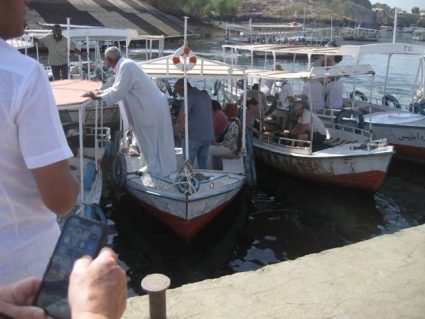
We hopped off to see the Temples of Philae. This island is also home to the Great Temple of Isis who is the main deity of the island. The earliest structures date to the Ptolemaic period (about 305-30 BC).
In 1902 the monuments of Philae were submerged for most of the year after construction of the Aswan Dam. By 1960 the rising waters of Lake Nasser were threatening to permanently submerge the monuments on the island.
At the request of the Egyptian government, an international effort led by UNESCO successfully relocated the Philae’s monument to the nearby Island of Agikia.
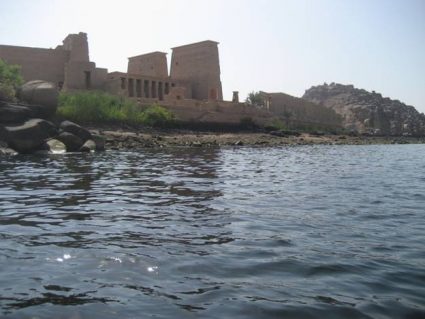
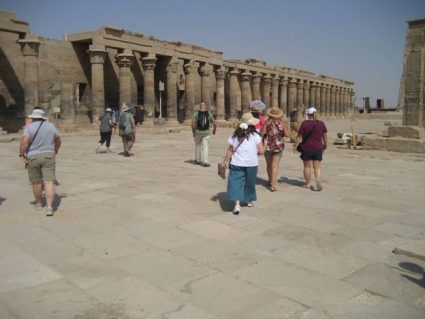
Our guide pointed out that all the tops of the columns are different from each other.
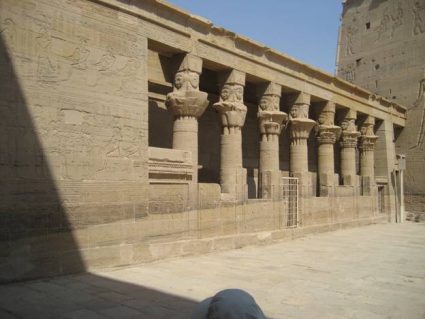
Early Christians used the main temple on the island as a church. This is the reason for the defacement of some of the figures of the ancient gods as these Christians often tried to remove the pagan imagery from their newly claimed sanctuaries. In the picture below, careful examination of the two images to the left of the entrance shows this defacement.
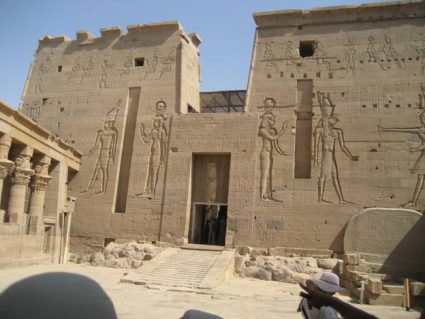
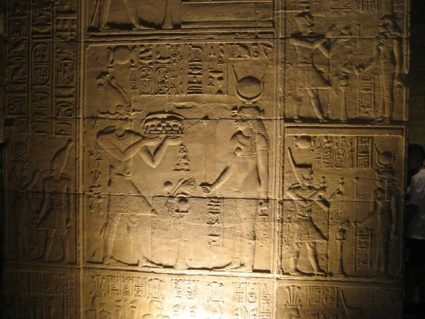
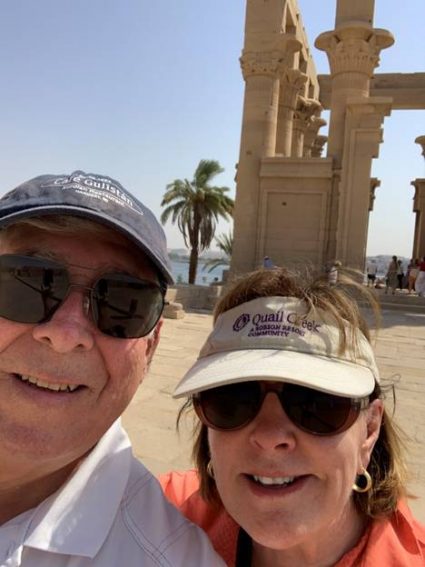
We returned to our little motorboat and returned to our waiting van on the bank of the Nile. From here we drove to the top of the new Aswan Dam.
Below is a graphic showing a cross-section of the dam construction.
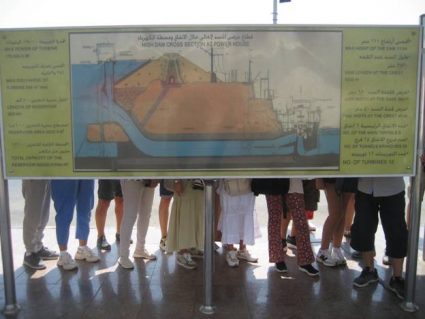
This dam is massive and very impressive.
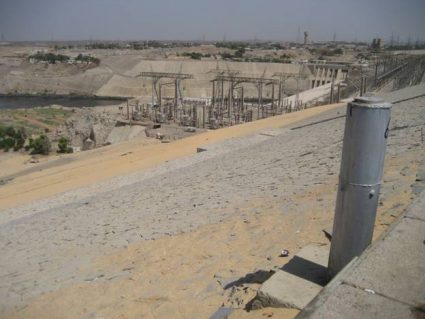
We left the dam and drove to the Nubian Museum. Keeping in mind that the Nile River flows from south (higher) to north (lower), we were visiting Lower Nubia.
The mines and quarries of Lower Nubia produced much of the gold that enriched the early Egyptians.
The mines also produced the beautiful red Egyptian granite. Immense blocks of this Aswan granite are found in many Egyptian ruins.
The procedure by which the old Egyptian stone masons extricated the blocks is interesting. At distances generally about 6 inches they chiseled holes in the rock. Wooden wedges were forcibly driven into these holes and these wedges were made to swell by being moistened and the rock was thus made to split.
From here we boarded a flight and returned to Cairo. We checked into the Le Meridien Hotel at the Cairo Airport.
Sunday October 8, 2023
This was our last full day in Cairo. It is also when we learned of the deadly Hamas incursion into Israel from Gaza. While Egypt borders Israel and Gaza, they are a considerable distance from Cairo.
After breakfast, we boarded our van and drove to the Bent Pyramid.
The Bent Pyramid rises from the desert at a 54-degree inclination, but the top section (above 47 meters) is built at the shallower angle of 43 degrees, lending the pyramid a visibly ‘bent’ appearance.
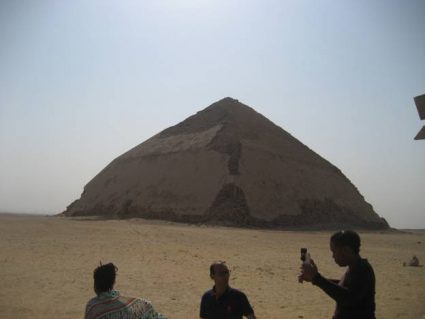
Archaeologists now believe that the Bent Pyramid represents a transitional form between step-sided and smooth-sided pyramids. It has been suggested that due to the steepness of the original angle of inclination the structure may have begun to show signs of instability during construction, forcing the builders to adopt a shallower angle to avert the structure’s collapse.
It is also unique among the approximately ninety pyramids to be found in Egypt, in that its original polished limestone outer casing remains largely intact. British structural engineer Peter James attributes this to larger clearances between the parts of the casing than used in later pyramids; these imperfections would work as expansion joints and prevent the successive destruction of the outer casing by thermal expansion.
Below is the entrance to the pyramid. Pat and I climbed the steps but chose not to enter the tomb.
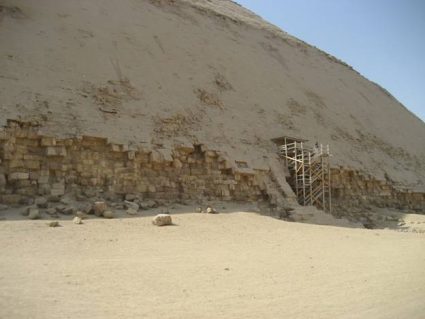
We again boarded our van and went to the National Museum of Egyptian Civilization in Cairo. This is a beautiful facility.
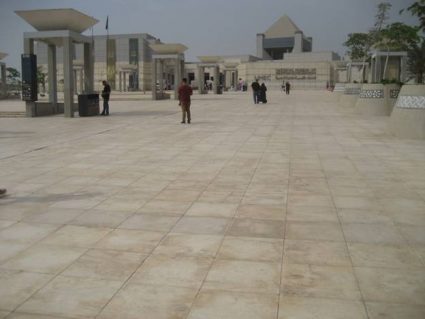
This is the first museum in the Arab world focusing on the earliest civilization in history – the ancient Egyptian civilization. It is the only museum in Egypt that offers the visitor a general overview of all the different historical periods that encompass Egypt. This has been approached as a layered cumulative product regarding the interaction of the Egyptian people with their land throughout history. This has been created via a multidisciplinary thematic approach designed to highlight Egypt’s tangible and intangible heritage.
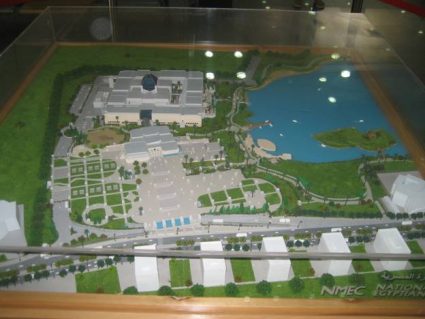
Inside were a collection of mummies removed from temples all over Egypt.
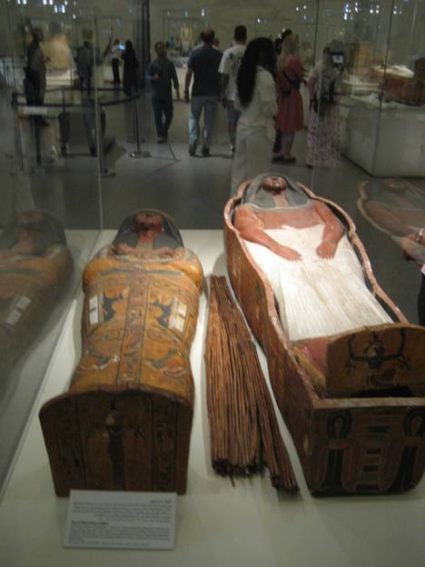
This was the last stop on our tour of Egypt. We returned to our hotel and Pat was able to swim in the hotel pool. We enjoyed our final dinner and got rested for our return home the following morning.
Saturday October 9, 2023
We had a nice breakfast at our hotel.
In spite of the hotel being at the airport, we were picked up by an A&R van and driven around to the departure entrance. The A&R representative stayed with us through the ticketing and baggage check process. Then we were on our own.
Presumably due to the Hamas attack on Israel we were subjected to three inspections to get to the departure gate. The final inspection separated men and women and was a full-body pat down.
Our flight departed on time and the return trip was uneventful.


